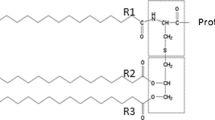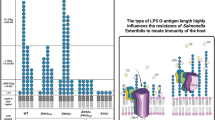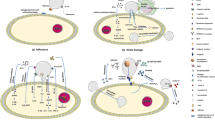Abstract
Caseous lymphadenitis (CLA) is an infectious disease caused by Corynebacterium pseudotuberculosis in small ruminants and is characterized by the development of granulomas in the lymph nodes, spleen, liver, and lungs. Although little is known about the host-pathogen relationship of this bacterium, it was previously reported that the pathogen’s lipids are important for its taxonomic classification and survival inside macrophages. However, there are no studies regarding the composition of these molecules. In this study, cell wall glycolipids from two C. pseudotuberculosis strains presenting different virulence profiles were purified and its composition was characterized. A difference was observed between the electrophoretic and chromatogram profiles for cell wall components from the two strains, mainly among molecules with low molecular weights. IgM from sheep with acute CLA recognized antigens with an estimated molecular weight of 11 kDa of the low-pathogenicity strain, while low-molecular weight antigens from the high-pathogenicity strain presented a lower recognition by these antibodies. Mass spectrometry analysis showed that the cell wall of the high-pathogenicity strain contained glycolipids with high amounts of unsaturated fatty acids and glycerophosphoinositols, which may contribute to the capacity of this strain to cause severe disease. In conclusion, it is indicated that cell wall non-protein antigens can play a key role in C. pseudotuberculosis virulence.





Similar content being viewed by others
Availability of data and material
All data and material are available under request.
Code availability
Not applicable.
References
Dorella FA, Estevam EM, Pacheco LG, Guimarães CT, Lana UG, Gomes EA et al (2006) In vivo insertional mutagenesis in Corynebacterium pseudotuberculosis: an efficient means to identify DNA sequences encoding exported proteins. Appl Environ Microbiol 72:7368–7372. https://doi.org/10.1128/AEM.00294-06
Meyer R, Regis L, Vale V, Paule B, Carminati R, Bahia R, Moura-Costa L, Schaer R, Nascimento I, Freire S (2005) In vitro IFN-gama production by goat blood cells after stimulation with somatic and secreted Corynebacterium pseudotuberculosis antigens. Vet Immunol Immunopathol 107:249–254. https://doi.org/10.1016/j.vetimm.2005.05.002
Hamasur B, Haile M, Pawlowski A, Schröder U, Williams A, Hatch G, Hall G, Marsh P, Källenius G, Svenson SB (2003) Mycobacterium tuberculosis arabinomannan-protein conjugates protect against tuberculosis. Vaccine 21:4081–4093. https://doi.org/10.1016/s0264-410x(03)00274-3
Mishra AK, Alderwick LJ, Rittmann D, Tatituri RV, Nigou J, Gilleron M et al (2007) Identification of an α(1-6) mannopyranosyltransferase (MptA), involved in Corynebacterium glutamicum lipomannan biosynthesis, and identification of its orthologue in Mycobacterium tuberculosis. Mol Microbiol 65:1503–1517. https://doi.org/10.1111/j.1365-2958.2007.05884.x
Mishra AK, Klein C, Gurcha SS, Alderwick LJ, Babu P, Hitchen PG, Morris HR, Dell A, Besra GS, Eggeling L (2008) Structural characterization and functional properties of a novel lipomannan variant isolated from a Corynebacterium glutamicum pimB′ mutant. Antonie Van Leeuwenhoek 94:277–287. https://doi.org/10.1007/s10482-008-9243-1
Hard GC (1972) Examination by electron microscopy of the interaction between peritoneal phagocytes and Corynebacterium ovis. J Med Microbiol 5:483–491. https://doi.org/10.1099/00222615-5-4-483
Muckle CA, Gyles CL (1982) Characterization of strains of Corynebacterium pseudotuberculosis. Can J Comp Med 46:206–208
Puech V, Chami M, Lemassu A, Lanéelle MA, Schiffler B, Gounon P et al (2001) Structure of the cell envelope of corynebacteria: importance of the non-covalently bound lipids in the formation of the cell wall permeability barrier and fracture plane. Microbiology 147:1365–1382. https://doi.org/10.1099/00221287-147-5-1365
Burkovski A (2018) The role of corynomycolic acids in Corynebacterium-host interaction. Antonie Van Leeuwenhoek 111:717–725. https://doi.org/10.1007/s10482-018-1036-6
Vercellone A, Nigou J, Puzo G (1998) Relationships between the structure and the roles of lipoarabinomannan and related glycoconjugates in tuberculosis pathogenesis. Front Biosci 3:e149–e163
Giraldo M, Cannizarro H, Ferguson MA, Almeida IC, Gazzinelli RT (2000) Fractionation of membrane components from tachyzoite forms of Toxoplasma gondii: differential recognition by immunoglobulin M (IgM) and IgG present in sera from patients with acute or chronic toxoplasmosis. J Clin Microbiol 38:1453–1460
Moura-Costa LF, Bahia RC, Carminati R, Vale VL, Paule BJ, Portela RW et al (2008) Evaluation of the humoral and cellular immune response to different antigens of Corynebacterium pseudotuberculosis in Canindé goats and their potential protection against caseous lymphadenitis. Vet Immunol Immunopathol 126:131–141. https://doi.org/10.1016/j.vetimm.2008.06.013
de Souza AP, Vale VL, Silva MC, Araújo IB, Trindade SC, Moura-Costa LF et al (2014) MAPK involvement in cytokine production in response to Corynebacterium pseudotuberculosis infection. BMC Microbiol 14. https://doi.org/10.1186/s12866-014-0230-6
Almeida S, Loureiro D, Portela RW, Mariano DC, Sousa TJ, Pereira FL et al (2016) Complete genome sequence of the attenuated Corynebacterium pseudotuberculosis strain T1. Genome Announc 4. https://doi.org/10.1128/genomeA.00947-16
Almeida S, Tiwari S, Mariano D, Souza F, Jamal SB, Coimbra N, Raittz RT, Dorella FA, Carvalho AF, Pereira FL, Soares SC, Leal CAG, Barh D, Ghosh P, Figueiredo H, Moura-Costa LF, Portela RW, Meyer R, Silva A, Azevedo V (2016) The genome anatomy of Corynebacterium pseudotuberculosis VD57 a highly virulent strain causing Caseous lymphadenitis. Stand Genomic Sci 11:29. https://doi.org/10.1186/s40793-016-0149-7
Giraldo M, Portela RW, Snege M, Leser PG, Camargo ME, Mineo JR et al (2002) Immunoglobulin M (IgM)-glycoinositolphospholipid enzyme-linked immunosorbent assay: an immunoenzymatic assay for discrimination between patients with acute toxoplasmosis and those with persistent parasite-specific IgM antibodies. J Clin Microbiol 40:1400–1405. https://doi.org/10.1128/jcm.40.4.1400-1405.2002
de Carvalho RVH, Andrade WA, Lima-Junior DS, Dilucca M, de Oliveira CV, Wang K, Nogueira PM, Rugani JN, Soares RP, Beverley SM, Shao F, Zamboni DS (2019) Leishmania lipophosphoglycan triggers caspase-11 and the non-canonical activation of the NLRP3 inflammasome. Cell Rep 26:429–437.e5. https://doi.org/10.1016/j.celrep.2018.12.047
Scheer JM, Ryan CA (2001) A method for the quantitative recovery of proteins from polyacrylamide gels. Anal Biochem 298:130–132. https://doi.org/10.1006/abio.2001.5384
Rebouças MF, Loureiro D, Bastos BL, Moura-Costa LF, Hanna SA, Azevedo V, Meyer R, Portela RW (2013) Development of an indirect ELISA to detect Corynebacterium pseudotuberculosis specific antibodies in sheep employing T1 strain culture supernatant as antigen. Pesqui Vet Bras 33:1296–1302. https://doi.org/10.1590/S0100-736X2013001100002
Fahy E, Sud M, Cotter D, Subramaniam S (2007) LIPID MAPS online tools for lipid research. Nucleic Acids Res 35:W606–W612. https://doi.org/10.1093/nar/gkm324
Burkovski A (2013) Cell envelope of Corynebacteria: structure and influence on pathogenicity. ISRN Microbiol 2013:1–11. https://doi.org/10.1155/2013/935736
Suleiman KM, Boehnel H, Babiker SH, Saki AZSA (2006) Cellular fatty acid profile of Corynebacterium pseudotuberculosis and its relation to pathogenicity. J Anim Vet Adv 5:943–945
Coloe PJ, Sinclair AJ, Slattery JF, Burke D (1984) Differentiation of Brucella ovis from Brucella abortus by gas-liquid chromatographic analyses of cellular fatty acids. J Clin Microbiol 19:896–898
Niehus S, Smith TK, Azzouz N, Campos MA, Dubremetz JF, Gazzinelli RT, Schwarz RT, Debierre-Grockiego F (2014) Virulent and avirulent strains of Toxoplasma gondii which differ in their glycosylphosphatidylinositol content induce similar biological functions in macrophages. PLoS One 9:e85386. https://doi.org/10.1371/journal.pone.0085386
Leal KS, de Oliveira Silva MT, Rezende ADFS, Bezerra FSB, Begnini K, Seixas F et al (2018) Recombinant M. bovis BCG expressing the PLD protein promotes survival in mice challenged with a C. pseudotuberculosis virulent strain. Vaccine. https://doi.org/10.1016/j.vaccine.2018.05.049
Brum AA, Rezende ADFS, Brilhante FS, Collares T, Begnine K, Seixas FK et al (2017) Recombinant esterase from Corynebacterium pseudotuberculosis in DNA and subunit recombinant vaccines partially protects mice against challenge. J Med Microbiol 66:635–642. https://doi.org/10.1099/jmm.0.000477
Sousa TJ, Parise D, Profeta R, Parise MTD, Gomide ACP, Kato RB et al (2019) Re-sequencing and optical mapping reveals misassemblies and real inversions on Corynebacterium pseudotuberculosis genomes. Sci Rep 9:16387. https://doi.org/10.1038/s41598-019-52695-4
Garton NJ, Gilleron M, Brando T, Dan HH, Giguère S, Puzo G, Prescott JF, Sutcliffe IC (2002) A novel lipoarabinomannan from the equine pathogen Rhodococcus equi. Structure and effect on macrophage cytokine production J Biol Chem https://doi.org/10.1074/jbc.M203008200, 277, 31722, 31733
Torrelles JB, DesJardin LE, MacNeil J, Kaufman TM, Kutzbach B, Knaup R et al (2009) Inactivation of Mycobacterium tuberculosis mannosyltransferase pimB reduces the cell wall lipoarabinomannan and lipomannan content and increases the rate of bacterial-induced human macrophage cell death. Glycobiology 19:743–755. https://doi.org/10.1093/glycob/cwp042
Tatituri RV, Alderwick LJ, Mishra AK, Nigou J, Gilleron M, Krumbach K et al (2007) Structural characterization of a partially arabinosylated lipoarabinomannan variant isolated from a Corynebacterium glutamicum ubiA mutant. Microbiology 153:2621–2629. https://doi.org/10.1099/mic.0.2007/008078-0
Bastos BL, Meyer R, Guimarães JE, Ayres MC, Guedes MT, Moura-Costa LF, de Burghgrave US, Sena L, Azevedo V, Portela RW (2011) Haptoglobin and fibrinogen concentrations and leukocyte counts in the clinical investigation of caseous lymphadenitis in sheep. Vet Clin Pathol 40:496–503. https://doi.org/10.1111/j.1939-165X.2011.00355.x
Bastos BL, Loureiro D, Raynal JT, Guedes MT, Vale VLC, Moura-Costa LF, Guimarães JE, Azevedo V, Portela RW, Meyer R (2013) Association between haptoglobin and IgM levels and the clinical progression of caseous lymphadenitis in sheep. BMC Vet Res 9:254. https://doi.org/10.1186/1746-6148-9-254
Gunstone FD, Harwood JL, Dijkstra AJ (2007) The lipid handbook. CRC Press, Boca Raton
Nowicka B, Kruk J (2010) Occurrence, biosynthesis and function of isoprenoid quinones. Biochim Biophys Acta 1797:1587–1605. https://doi.org/10.1016/j.bbabio.2010.06.007
Disch A, Schwender J, Müller C, Lichtenthaler HK, Rohmer M (1998) Distribution of the mevalonate and glyceraldehyde phosphate/pyruvate pathways for isoprenoid biosynthesis in unicellular algae and the Cyanobacterium synechocystis PCC 6714. Biochem J 333:381–388. https://doi.org/10.1042/bj3330381
O’Leary WM (1962) Fatty acids of bacteria. Bacteriol Rev 26:429
Fraenkel G, Friedmann S (1957) Carnitine. Vitam Horm 15:73–118
Rebouche CJ, Sein H (1998) Carnitine metabolism and its regulation in microorganisms and mammals. Annu Rev Nutr 18:39–61. https://doi.org/10.1146/annurev.nutr.18.1.39
Fozo EM, Scott-Anne K, Koo H, Quivey RG Jr (2007) Role of unsaturated fatty acid biosynthesis in virulence of Streptococcus mutans. Infect Immun 75:1537–1539. https://doi.org/10.1128/IAI.01938-06
Ridgway ND (2005) The role of phosphatidylcholine and choline metabolites to cell proliferation and survival. Crit Rev Biochem Mol Biol 48:20–38. https://doi.org/10.3109/10409238.2012.735643
Haites RE, Morita YS, McConville MJ, Billman-Jacobe H (2005) Function of phosphatidylinositol in mycobacteria. J Biol Chem 280:10981–10987. https://doi.org/10.1074/jbc.M413443200
Tascon RE, Soares CS, Ragno S, Stavropoulos E, Hirst EM, Colston MJ (2000) Mycobacterium tuberculosis-activated dendritic cells induce protective immunity in mice. Immunology 99:473–480. https://doi.org/10.1046/j.1365-2567.2000.00963.x
Nigou J, Gilleron M, Rojas M, García LF, Thurnher M, Puzo G (2002) Mycobacterial lipoarabinomannan: modulators of dendritic cell function and the apoptotic response. Microbes Infect 4:945–953. https://doi.org/10.1016/S1286-4579(02)01621-0
Fratti RA, Chua J, Vergne I, Deretic V (2003) Mycobacterium tuberculosis glycosylated phosphatidylinositol causes phagosome maturation arrest. Proc Natl Acad Sci U S A 100:5437–5442. https://doi.org/10.1073/pnas.0737613100
Ott L, Hacker E, Kunert T, Karrington I, Etschel P, Lang R, Wiesmann V, Wittenberg T, Singh A, Varela C, Bhatt A, Sangal V, Burkovski A (2017) Analysis of Corynebacterium diphtheriae macrophage interaction: dispensability of corynomycolic acids for inhibition of phagolysosome maturation and identification of a new gene involved in synthesis of the corynomycolic acid layer. PLoS One 12:e0180105. https://doi.org/10.1371/journal.pone.0180105
Bruna-Romero O, Rocha CD, Tsuji M, Gazzinelli RT (2004) Enhanced protective immunity against malaria by vaccination with a recombinant adenovirus encoding the circumsporozoite protein of Plasmodium lacking the GPI-anchoring motif. Vaccine 22:3575–3584. https://doi.org/10.1016/j.vaccine.2004.03.050
Assis RR, Ibraim IC, Noronha FS, Turco SJ, Soares RP (2012) Glycoinositolphospholipids from Leishmania braziliensis and L. infantum: modulation of innate immune system and variations in carbohydrate structure. PLoS Negl Trop Dis. https://doi.org/10.1371/journal.pntd.0001543
Barral TD, Mariutti RB, Arni RK, Santos AJ, Loureiro D, Sokolonski AR, Azevedo V, Borsuk S, Meyer R, Portela RD (2019) A panel of recombinant proteins for the serodiagnosis of caseous lymphadenitis in goats and sheep. Microb Biotechnol 12:1313–1323. https://doi.org/10.1111/1751-7915.13454
Acknowledgments
The authors are grateful to Francisca Soares (Labimuno-UFBA) for technical assistance.
Funding
This work was funded by Fundação de Apoio à Pesquisa do Estado da Bahia (FAPESB) grant number PPP 022/2009. VA is a research fellow from Conselho Nacional de Desenvolvimento Científico e Tecnológico (CNPq). RWP is a Technological Development fellow from CNPq (Proc. 313350 / 2019-1).
Author information
Authors and Affiliations
Contributions
MFR, DL, NS, JTR, TJS, HCPF, RWP: experimental procedures, data preparation and interpretation, and writing the manuscript. TDB: experimental procedures, reviewing the manuscript. MFR, TDB, RWP: writing the manuscript. VA, RM: manuscript preparation, funding acquisition. All authors read and approved the final manuscript.
Corresponding author
Ethics declarations
Conflict of interest
The authors declare that they have no conflict of interest.
Ethics approval
Not applicable.
Consent to participate
Not applicable.
Consent for publication
All authors consent for publication.
Additional information
Responsible Editor: Tânia A. Tardelli Gomes
Publisher’s note
Springer Nature remains neutral with regard to jurisdictional claims in published maps and institutional affiliations.
Electronic supplementary material
ESM 1
(PDF 11 kb)
Rights and permissions
About this article
Cite this article
Rebouças, M.F., Loureiro, D., Barral, T.D. et al. Cell wall glycolipids from Corynebacterium pseudotuberculosis strains with different virulences differ in terms of composition and immune recognition. Braz J Microbiol 51, 2101–2110 (2020). https://doi.org/10.1007/s42770-020-00343-9
Received:
Accepted:
Published:
Issue Date:
DOI: https://doi.org/10.1007/s42770-020-00343-9




